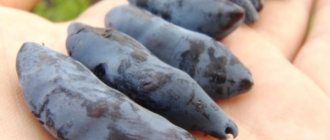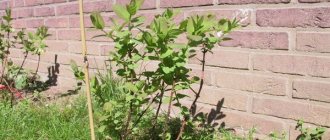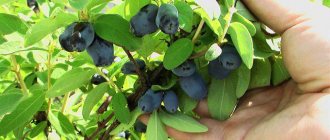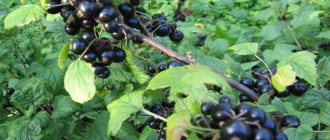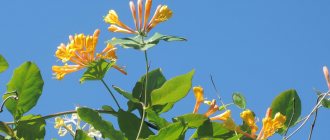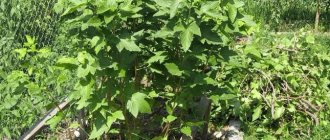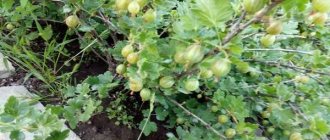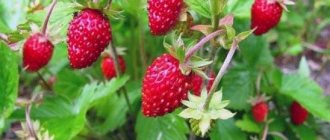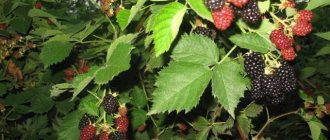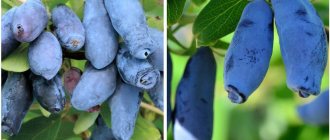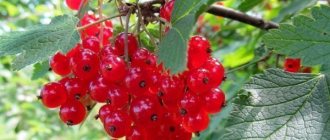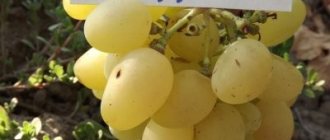Description
The Leningrad giant has the following characteristics:
- A medium-sized bush 1.6-2 m high with a rounded crown with a diameter of up to 1.5 m.
- The leaves are dark green, slightly pubescent, oval-elongated.
- The ripened bark is dark, mature and easily comes off the trunk.
- The flowers are pale yellow.
- The berries are dark blue, elongated cylindrical in shape with a sharp nose, large, slightly lumpy, weight up to 5 g, length up to 3.5 cm. The skin has a bluish coating, no pubescence.
We grow useful crops on our site
Preparing the place
Honeysuckle grows in many types of soil, but, most importantly, its roots must breathe well, and the water in the area should not stagnate. That is, you need to immediately put drainage in the hole, and look for a place in an area where there is no lowland, shade, no floods, no groundwater. Light is also needed for the crop, as this directly affects the yield and the quality of the berries - they accumulate more useful substances.
Remember, we said that this variety can grow up to 1.5 meters; such dimensions can solve some aesthetic imperfections in the landscape. Shrubs can be planted next to outbuildings, along a fence, border, or made into a hedge. Pay attention to the photo, this is how the Leningrad Giant honeysuckle can create a green fence line and decorate any area. Remember that you must buy not only seedlings of this variety, but also those listed above from pollinators. The distance must be calculated in advance at least 1.5 meters from each other.
Advice! Honeysuckle will perfectly coexist with black currants, dogwoods, and barberries on the site.
We meet deadlines
Honeysuckle can be planted in both spring and autumn. The culture is unpretentious in terms of weather and is not afraid of frost. Therefore, you can plant it already in April; in the fall, honeysuckle can be planted in September, October, and even in some regions in early November. We would also advise you to be guided by the lunar planting calendar in gardening matters - it is compiled for every year, and literally all dacha work is described in it by day.
Preparing the holes and planting honeysuckle
The area must be cleared of plant debris, removing all weed roots. The best fertilizers for honeysuckle are organic. In this case, you can use manure, litter, humus, and compost. The first two can be added to the hole at the rate of 1/10 and 1/20, the second can be scattered throughout the area and dug up the soil before planting. Next, you will feed the seedlings at 2-3 years of age.
You can also add double superphosphate into the hole according to the instructions, ash solution - 1 cup per liter. The latter will solve the problem of soil acidification. Wood ash and tobacco dust are also good remedies for pests and rodents. Often they are simply scattered throughout the site or along the beds. We remember that you will also need a layer of drainage, it could be sand, about 3 cm thick.
On a note! If you don't know what kind of soil you have, buy litmus paper at a gardening store or online. For honeysuckle "Leningrad Giant" the optimal indicator is 6-7 pH.
Pour drainage into the hole, add fertilizer, place the seedling in the middle, straighten the root, then fill it with soil, tamp it lightly and water it. The root collar should not be buried. In winter, you can lay a layer of mulch made from horse manure or spruce branches around the trunk. Also, during planting, the seedling is shortened by a third.
Qualitative varietal characteristics of the Leningrad giant
The variety has a number of features:
- Versatility of purpose - the berries are suitable for processing into preserves and jams. Thanks to its dense skin, it tolerates storage and transportation well.
- Ripening period is average (late June - early July).
- Productive - a young plant produces from 1 to 3 kg per bush; in subsequent years, under favorable conditions, it can produce up to 5 kg.
- Early fruiting - the first fruits appear in the second or third year and maintain good productivity for 25-30 years.
Description of the variety
The Leningrad giant is characterized by early ripening and can grow in one place for about 30 years.
The average height of a vigorous, erect bush is 1.5 meters with a slightly spreading, average dense crown diameter of 1.6 meters. The bark is brown, with a shade of gray or red, and is easily separated from the trunk by longitudinal narrow strips. The leaves are dull green, rounded, slightly pubescent. The root system is fibrous, superficial type.
Honeysuckle Leningrad giant, the description of the variety of which arouses the interest of most gardeners, is a winter-hardy plant. Flowers and young ovaries can tolerate spring frosts down to -7 ° C, and wood and roots - up to -40 ° C.
The plant is practically not susceptible to infection by diseases and pests. Consequently, it does not require chemical treatments, which results in environmentally friendly and healthy berries. The variety was bred at the Pavlovsk experimental station in St. Petersburg (Russia) using the seed method. The original form is Kamchatka wild honeysuckle.
Advantages and disadvantages
Like any variety, the Leningrad Giant has its strengths and weaknesses.
The advantages of the variety include:
- The berries are sweet and large, with no bitterness at all, so the variety is considered elite and is used as a donor for the creation of new varieties.
- Resistant to powdery mildew and pests.
- The berries are collected in clusters, making harvesting easier.
- Due to its frost resistance (up to -40 degrees), it grows well in open areas without additional fencing.
- Resistant to re-blooming.
- Weak berry shedding - ripe berries stay on the stalk longer, reducing yield losses.
- The bush holds its shape well and does not fall apart.
The disadvantages are:
- The variety is self-sterile and requires pollinators (Blue Spindle, Pamyati Kuminova, Morena, Malvina, Start and Blue Bird).
- The berries ripen unevenly.
- Weak aroma.
Advantages and disadvantages
Leningradsky Giant is ideal for processing. The variety has other advantages:
- High yield.
- Winter hardiness up to 40 degrees below zero.
- Leningradsky Giant is the sweetest variety.
- Stability of fruiting.
- Resistance to re-blooming.
- Large fruit.
- The berries fall off slightly.
- Rapid entry into fruiting - a decent harvest can be collected 2-3 years after planting.
- Thanks to the heap arrangement of the berries, their harvesting is simplified.
- Undemanding to growing conditions.
- The bush bears fruit for 30 years.
The disadvantages of the variety include:
- Unripe berries have a fresh taste.
- Self-sterility.
- Uneven ripening of berries.
Comment! Although the fruits have a rating of 4.8 points, they are, as they say, not for everybody. Their taste is too sweet, the aroma is weak, and the sourness of ripe berries is not noticeable.
Landing rules
The variety grows well in the middle zone and in the north-west of Russia.
Where to plant?
It is advisable to place the bushes in a sunny area, since in the shade the yield is significantly reduced.
It is not too picky about the soil; loose, fertile soil with weak acidity, or sandy loam soil is better suited. The plant feels worse on sandy soil, and also does not like areas where the groundwater level is high.
In acidic soil, the foliage loses its color saturation, and the yield is significantly reduced.
Landing dates
Planting of seedlings is carried out during the dormant period of the plant. For honeysuckle this is the period from late July (when fruiting ends) - early August to November. Honeysuckle begins to awaken early in the spring, so in the spring months the survival rate drops by 20%.
Selection of seedlings
To select good, viable seedlings, when purchasing, you should give preference to bushes grown in containers. The plant must have a certificate describing the variety, age and pollinators.
Carefully inspect the seedlings and select those that have:
- Age 2-3 years.
- Height up to 40 cm.
- 2-3 flexible branches.
- Live buds.
- Equal internodes.
Large plants are not worth buying; they tolerate transplanting less well and begin to bear fruit later.
Subtleties of landing
Since the crown of this variety of honeysuckle is large, plant the bushes at a distance of at least 2.5-3 meters from each other.
There is no need to shorten branches when planting, as this will delay growth and fruiting.
Landing rules:
- Three weeks before planting, dig a hole measuring 50x50 cm. Place drainage and soil in it, consisting of:
- 20 liters of humus;
- 30 g superphosphate;
- 30 g of potassium salt (500 g of ash).
- 2 hours before planting, to awaken and saturate with moisture, immerse the roots of the plant in water (possibly with a growth stimulator).
- Fill the planting hole with water. When the liquid is absorbed, form a hill from the soil in the middle of the hole and lower the bush onto it.
- Gently straighten the roots.
- Sprinkle the seedling, deepen the root collar by 5 cm, and compact the soil. Pour 10 liters of water under the bush.
- Mulch the tree trunk circle with hay or straw about 10 cm thick.
Features of cultivation
The Leningrad giant can be grown in any region: in the north-west of the country and in the middle zone. The optimal time for planting is in the summer, after the heat subsides and frosts are not expected. You can plant a shrub in the spring, but it will take longer to take root than with summer planting. You need to buy honeysuckle seedlings only in trusted places: at gardening fairs and nurseries. A closed root system is preferable, so the roots are protected and not damaged. When purchasing, pay attention to the branches: in a healthy plant they are elastic and straight, without damage, with equal internodes. If the bark comes off, it’s okay, this is a feature of the variety.
Attention! The seedlings should be between 2 and 3 years old. Older plants cannot be purchased.
The Leningrad giant loves sunlight, then the berries ripen faster. If honeysuckle has not been grown on the site before, then set aside a place protected from the wind for planting it. You cannot grow shrubs in hollows and holes; moisture accumulates there, and then the root system rots. The variety is not too demanding in terms of soil composition: any loose soil with a slightly acidic reaction will do. Before planting, add nutrients to the soil, preferably organic matter. You can add superphosphate and potassium sulfate to improve the composition. If the earth is very acidic, it is neutralized with dolomite flour.
Since the Leningrad giant does not grow more than 2 m in height and has a compact crown, the shrub does not require much space for growing. The planting hole should be 50x50x50 cm. It is filled with water, and after it is absorbed, a hill is made from the soil, a seedling is inserted into the center, deepening the root collar by 4-5 cm. The soil is compacted, then watered and mulched.
Tips for growing grapes
Honeysuckle Blue spindle: planting and caring for the variety
Honeysuckle Nymph - how to plant and grow on your site
Honeysuckle Cinderella: description of the variety and characteristics of the berries
Agrotechnical measures
Watering and loosening
Honeysuckle loves watering, so it is important to monitor the soil moisture in the tree trunk:
- Water the young seedling regularly, preventing the earthen ball from drying out. A bush requires 10-15 liters of water. And in hot and dry periods up to 30 liters.
- When the soil on top dries, loosen it, but not deeper than 5-8 cm, since honeysuckle has a superficial root system and the roots can be damaged.
- Water an adult bush only during periods of severe drought.
- Regularly loosen the tree trunk and remove weeds.
- Honeysuckle also loves sprinkling, especially at the time of fruit set - in the second half of May, but not during the period of flowering and ripening of berries. Water can knock pollen off flowers and the harvest will be poor.
Feeding
Since the necessary fertilizers were placed in the hole when planting the seedling, for the first couple of years it is enough to water it in the spring with a solution of ammonium nitrate (urea) - 10 liters per bush.
Then the reserves of nutrients in the soil are depleted, and from the age of 3 the plants require additional feeding:
- In early spring, before the snow has melted, apply nitrogen-containing fertilizer.
- In summer, at the end of fruiting, feed with complex mineral fertilizer.
- At the beginning of autumn, apply potassium-phosphorus fertilizer (per 1 sq. m: 30 g of superphosphate and 20 g of potassium salt), once every 3-4 years it is advisable to add rotted compost or humus.
Trimming
From the age of three, in the fall, during the dormant period, only sanitary pruning is carried out, during which only weak, broken, crown-thickening, bent to the ground and diseased branches are removed.
At the age of 6-7 years, the bushes are rejuvenated once; for this, 2-3 old shoots are gradually cut out over several seasons, leaving the same number of young ones in return.
Further, up to 15 years, only sanitary trimmings are sufficient.
In subsequent years, the old branches are cut down every season. And after 20 years (if the harvest has decreased significantly), the bush is pruned, leaving stumps of 15-20 cm. After such a radical rejuvenation, the honeysuckle will bear fruit for another 10 years.
We recommend reading the article on how to care for honeysuckle in the autumn.
Preparing for winter
Leningradsky Giant is a frost-resistant variety (up to -40 degrees) and therefore does not require winter shelter. After leaf fall, it is enough to remove all fallen leaves and the remains of mulch in the tree trunk circles.
Reproduction
Honeysuckle can be propagated in three ways:
- Dividing a bush is the simplest, carried out only with plants 6-7 years old and older. The bush is dug up and divided. The halves are seated in planting holes. Honeysuckle will begin to bear fruit in the second year.
- Reproduction by layering - the lower branches are bent to the ground and dug in. The next year, when these branches give roots, they are separated from the parent bush and transplanted to a permanent place. It begins to bear fruit in the 3rd year.
- Propagation by cuttings - this method is not very productive, since cuttings take root difficultly and require certain conditions. For cuttings, a branch 15 cm long is cut from a 2-year-old bush (and older), from which the crown is removed. The cutting is placed in a growth stimulator for 2-3 hours. Next, they are placed in wet sand under film for 3-4 weeks. Rooted cuttings are taken out into the garden for the winter, and in the spring they are planted in a permanent place.
- Reproduction by seeds - The parental properties of honeysuckle are not transmitted, and the result will be unpredictable, so it is of interest only to breeders. The seeds are sown in a container and planted in a ridge in the spring. After a year, the seedlings are transplanted to a permanent place. Fruits in 3-4 years from the moment of sowing.
Agricultural technology
Honeysuckle bushes planted on well-dressed soil do not need feeding for the first 2 years. They don't do any pruning either. Young plants are only watered, weeded and mulched.
Watering and loosening
During the season, honeysuckle should be watered at least 5 times, and more often during dry periods. Watering is especially important at the time of formation of the ovaries, at the end of May - it helps to increase the weight of berries by 15%. Lack of moisture negatively affects the taste of the fruit. On average, 15 liters of water are consumed per bush; during the fruit-filling period, in the absence of rain, the amount is increased to 30 liters.
Recent Entries
5 working ways to use tar in the garden 7 indoor plants that help you get married even in adulthood Indoor plants that can bloom in trouble
Water kept in the sun is introduced into circular grooves made around the plant. You can water the entire bush using a hose with a sprayer. Sprinkling not only irrigates the soil, branches, and foliage, but also increases air humidity. However, during flowering, this type of watering is unacceptable, since water can wash away pollen and weaken pollination.
After watering and rain, when moisture is absorbed into the soil, the root zone is carefully loosened so as not to damage the suction roots located in the surface layer. Then a layer of mulch is laid, which promotes less evaporation of moisture and retards the growth of weeds.
Feeding
Only from the third season do honeysuckle begin to be fed. In spring, nitrogen fertilizers are applied under the bushes (2 tablespoons of urea/10 l). Since the crop prefers organic feeding, after the snow melts, instead of mineral feeding, it is better to fertilize it with 10 kg of humus. In the phase of bud protrusion and ovary formation, the bushes are watered with an ash solution (1 l/10 l). In the fall, 5 kg of compost, 100 g of ash and 40 g/m2 of superphosphate are added to the tree trunk circle; potassium salt (15 g/m2) is added every 2 years.
Honeysuckle prefers organic fertilizers to mineral fertilizers
If Ava complex fertilizer was used during planting, once every 3 years at the end of the season, 1 tbsp is applied to the bush. l. of this composition and embedded in the soil. In this case, no more mineral fertilizers will be required. Only after fruiting should organic matter (a bucket of humus) be added annually to the bush.
Trimming
Pruning of the bush begins in the third season, forming a sparse crown. Honeysuckle grows quickly, so as not to thicken the bush, only 5 strong branches are left, the basal shoots, non-fruit-bearing small weak branches, and branches of the shaded first tier must be completely cut out. Thinning pruning is carried out in the fall, after the leaves have fallen, at negative night temperatures.
Pruning is necessary to form a sparse honeysuckle bush
Since flower buds with the future harvest are laid during the summer in the axils of the upper leaves, it is impossible to trim the upper part of the shoots of honeysuckle. At the end of each season, dry, broken branches and damaged parts of the crown are also removed to make healthy wood.
By the age of 7, the yield of the berry bush decreases; in this case, anti-aging pruning is required. For several seasons in a row, 2 old branches are cut off at the root, replacing them with 3 young shoots, so the bush gradually rejuvenates.
You can apply radical pruning by cutting off all stems at a level of 50 cm from the ground. Young shoots will soon appear on the stumps, and the bush will be completely restored.
Preparing for winter
Honeysuckle is distinguished by unprecedented frost resistance: shoots are not afraid of extreme subzero temperatures (-50°C), roots do not freeze at -40°C, flowers and ovaries are not damaged at -8°C. The bushes do not require any shelter; on the eve of cold weather, they only water (30 l/plant) and lay a layer of compost.
Under a snow coat, honeysuckle bushes will withstand even severe frosts well
Only with sudden changes in air temperature in winter from -41°C to thaws (2°C) is minor damage to flower buds and shoot tips possible. However, plants, having good regenerative ability, quickly adapt to local conditions.
Reproduction
Honeysuckle is not difficult to propagate using seeds, but with this method the parental properties are lost, so it is mainly used by breeders.
During vegetative propagation, varietal properties are preserved. For propagation by lignified cuttings, at the end of autumn, annual growths are cut into pieces of 20 cm. Such cuttings are stored in sand or sawdust until spring. As soon as the ground thaws, they are planted in a greenhouse at an angle of 45°, regularly watered and opened slightly for ventilation. After a month, roots appear. Transplantation to the site is carried out in the fall.
When propagated by cuttings, the varietal characteristics of honeysuckle are completely preserved
Green cuttings 12 cm long are cut from annual growths at the end of flowering and planted in containers with fertile soil, watered and covered with film. For better rooting, you can use Aquadon, which will not only nourish the plants with the necessary microelements, but also keep the soil moist for a long time. The greenhouse must be opened slightly for ventilation and the soil must not be allowed to dry out. The following autumn, the grown plants are planted in the garden. Such cuttings have the highest survival rate.
The easiest way to propagate honeysuckle is through layering. In June, the top of the shoot is sprinkled with a 5 cm layer of soil, pinned down and watered. It should be separated from the mother plant and planted next year in the fall.
The easiest way to propagate honeysuckle is using apical layering
Honeysuckle propagates very easily by dividing the bush. A bush no older than 5 years is divided into parts with roots and 2-3 branches. Since the wood of honeysuckle is very strong, dividing the bush is carried out using a saw or an ax. Each bush is planted separately.
Video: honeysuckle propagation
Prevention of diseases and pests
The Leningrad Giant is resistant to pests and diseases. For prevention, the plant is treated with special preparations.
Bushes can be sprayed with pesticides only during the dormant period and in the spring before the leaves bloom. And during fruit set and fruiting, all treatments with fungicides are prohibited, so organic preparations are used to combat fungi and parasites during this period.
Table of the main diseases and pests of honeysuckle, ways to combat them:
| Pests and diseases | Signs | What to do? |
| Leaf roller caterpillars, borers | Leaves and shoots are eaten by larvae. The leaves on the branch become smaller and dry out. | Treat with appropriate insecticides or biological products (Decis, Intra-Vir, Elexar). If the damage is severe, cut the branches at the base and burn them. |
| Aphids | Small insects - aphids - are noticeable on the branches; the shoots wither and turn yellow. | Treat with bioinsecticides (Fitoverm, tobacco-garlic infusion), or in early spring before buds open with Aktelik, Rogor, Confidor. |
| Shields | Growths appear on the branches that do not separate from the branch - these are larvae. | Cut off and burn the affected branches, and spray the plant with phytoverm, or Aktelik, Rogor, Confidor. |
| Honeysuckle mite | The leaves curl and fall off. | Treat with insecticides. |
| Nematode | A speckled pattern appears on the leaves. | Tear off and burn all damaged leaves |
| fingerwing | The fruits become limp and wrinkled. | Infusion of tomato and potato shoots. Treat the bush with a 0.2% chlorophos solution. To destroy larvae "Rogor" 0.2%, as well as "Intra-Vir". |
| Powdery mildew | There is a white cobweb-like coating on the shoots and leaves. | The bushes are treated with insecticides and biological products (Skol, Topaz, Fundazol). Affected shoots are cut out and burned. |
| Rezucha mosaic virus | Internodes are sharply reduced. There is active growth of lateral shoots from axillary buds. The plant dries out and dies. | Choose plants carefully when purchasing. If the shoots are damaged by frost in winter, cut them out so that the virus does not enter the plant through the wounds. |
Difficulties in growing
Despite its high resistance to pests and diseases, powdery mildew poses a danger to the variety. It affects both young plants and mature shrubs, especially if the weather is favorable for it - cold and high humidity. Powdery mildew can only be defeated with fungicidal preparations. They are used according to the instructions. To prevent the disease, spray with a solution of copper sulfate and Bordeaux mixture.
Another danger to the variety is represented by insects: scale insects, aphids, and leaf roller caterpillars. Pests eat leaves, penetrate under the bark and cause the death of the crop if measures are not taken and they are not exterminated from the site. To get rid of pests, gardeners use insecticides. They must be applied before flowering, otherwise pollinators - bees - will leave along with the pests. Treatments are carried out every 2 weeks. To prevent insects from appearing on plants, honeysuckle is sprayed with tobacco infusion, onion or garlic infusion. Strong odors repel pests.
Attention! The sweet berries of honeysuckle attract another pest to the site - birds. Sparrows and blackbirds can destroy most of the crop. Therefore, they do not delay the collection of ripe fruits and pick them immediately after reaching maturity. Stretch a net over the bushes - this will become reliable protection against birds.
Harvesting
The berries are picked as they ripen.
In honeysuckle, the berries ripen in stages: the first to ripen are the fruits on the top of the head, then in the depths of the bush, and the last to ripen are the lower berries.
Overripe berries fall to the ground, so before you start picking, it is advisable to lay dense material under the bush on which the crumbled berries will fall. Fruits that do not detach from the stalk are not picked, leaving them to ripen. After picking, the berries are carefully poured from the fabric into the rest of the harvest.
Photo of bush and berries
The variety is mid-season, the fruits ripen from the second half of June to the first half of July. The berries are resistant to shedding. The fruits in the photo are large and oblong. The weight of the berries reaches 4-5 g, length - 3.5 cm. The skin is dark blue, smooth, with small tubercles and a waxy coating. The pulp of the fruit is tender, sweet, with a slight sourness without bitterness.
We recommend that you familiarize yourself with Sibiryachka Honeysuckle
The berries are collected in clusters, which makes them easy to pick. The harvest ripens unevenly, so gardeners recommend gradually harvesting honeysuckle fruits. The berries can be used to make jams, preserves, and compotes. The fruits can be frozen or dried for the winter.
Reviews of honeysuckle Leningrad giant
★★★★★
Elvira, 43 years old, Member of the Winegrowers and Gardeners Club, Turai Garden, western Bashkiria. The variety grows slowly, but I like the berries, they are sweet, tasty and even larger in size than the Bakcharsky giant honeysuckle.
Many berries are double, apparently due to the local heat. ★★★★★
Andrey, 38 years old, amateur gardener, Moscow region. The bush has been growing for 10 years, already 2 meters in height.
The berry is tasty, but not as large as expected, and the harvest is not large. I still like the variety, I recommend it. Hide
Add your review
The honeysuckle variety “Leningrad Giant” is well suited for beginning gardeners and will delight you with sweet fruits and a good harvest for many years. At the same time, it requires minimal care and is resistant to most types of diseases and pests.
0
0
Copy link
Harvesting and transportation, keeping quality of berries
The mass harvest of Leningrad honeysuckle fruits in central Russia occurs around mid-July, as the berries begin to ripen towards the end of June. The fruiting period can be extended over time, so you should not be surprised that the berries can hang on the bushes even in August (if you believe the reviews of gardeners, some of them linger on the shoots almost until the end of summer and do not fall off).
The fruits of the bush are tasty and sweet, which is clearly noticeable even against the background of other varieties of the crop. Therefore, as soon as you notice an invasion of birds in the garden, you can safely pick the crop, paying attention to this process every few days.
It is recommended to put the berries in small wooden boxes or cardboard boxes, but only if they were not damaged during removal from the bush (crushed berries will not last long). The shelf life in fresh form is 3–5 days, after which the products will have to be processed into compotes, jams or preserves.
In general, the Leningrad Giant honeysuckle variety has proven itself well among Russian gardeners, so if you are interested in edible and relatively unpretentious varieties of such a useful crop, then this option certainly deserves attention.
The best varieties for the Leningrad region and the North-Western region
A selection of the best honeysuckle varieties will help you study the characteristics of each, compare the size and taste of the fruits, yield and early fruiting.
Dessert
The variety is mid-season, frost-resistant and unpretentious in cultivation. Medium-sized and spreading bushes consistently bear fruit both in sunny areas and in shade or partial shade. Leaves are rich green, oval. The color of the berries is interesting - purple, with a burgundy tint. Weight - about 2 g, the tear is dry, the skin is strong, with a waxy coating. The pulp is tender and juicy, the taste is sweet, with a pleasant sourness, no bitterness. The berries do not wrinkle or crack; they are used for storage and transportation.
Moraine
The mid-early variety is immune to diseases and is rarely damaged by pests. The harvest is harvested in mid-June, the fruits ripen smoothly and do not fall off. The bushes are vigorous, with greenish-brown shoots, the berries are large, weigh up to 1 g. The shape is elongated, pitcher-shaped, blue-blue in color, with a waxy coating. The pulp is juicy and aromatic, the taste is sweet and sour.
To increase productivity, 2-3 other varieties are planted next to Morena honeysuckle (for example, Blue Spindle, Viola). The berries are used to make jam or eaten fresh.
Nymph
Honeysuckle Nymph is common in all regions of Russia. It is easy to care for and is not affected by fungal diseases. The variety is frost-resistant down to -30°C, so the plant is not afraid of frost and cold. The ripening period is mid-early, the bushes are vigorous. The leaves are large, dark green, the flowers are large. The berries are elongated, spindle-shaped, the average weight of one is 0.8 g. The color is blue-blue, the surface is slightly lumpy. The taste is sweet and aromatic, the berry is good in any form.
Attention! To increase productivity, the first pruning of the plant is carried out 2-3 years after planting. In autumn, dry and short branches and shoots with poor growth are removed. After another 3-4 years, the honeysuckle is rejuvenated - all old branches are cut off, leaving only young shoots on the lower shoots.
Swan
The variety is mid-season, the first harvest is harvested in early or mid-July. Swan is resistant to shedding; the fruits remain on the branches for 3-4 weeks after ripening. The bushes are compressed, vigorous, the leaves are large. The berries are oval, with a curved base, blue-blue in color. The fruits are one-dimensional, average weight - 1.2 g, the skin is thick, the waxy coating is weak. The consistency is dense, gristly, the taste is sweet and sour. The tasting score of the berries is 4.8 points. Resistance to frost and drought is high.
Malvina
Medium-sized bushes with an oval crown look original in garden plots. The shoots are thin and straight, the leaves are dark green, large and oval. The berries are pear-shaped and elongated, weighing about 1 g per one. The color is blue-blue, with a thick layer of waxy coating. The taste is sweet and sour, the aroma is rich.
Honeysuckle Malvina is grown for personal consumption and on a production scale - the berries are transportable, have a shelf life, and do not spoil on the road.
Volkhova
Mid-season universal variety. The plant is medium-sized, with thick and straight shoots. The berries are oval, elongated, with a pointed tip. The weight of one is about 0.8 g, some specimens reach 1.4 g. The color is blue-blue, the peel is of medium thickness. The taste is sweet and delicate, tasting score - 4.7 points.
Yoke
Volkhova is not damaged by diseases or pests, but is susceptible to soil composition - for a regular harvest, it is recommended to add superphosphate, wood ash, and potassium salt to the soil. The variety requires planting a pollinator nearby and sufficient moisture.
Yoke
The plant is medium-sized, fast-growing, the shoots are straight, with weak pubescence. The variety is early-bearing and begins to bear fruit 3 years after planting. It is unpretentious in cultivation and is rarely affected by diseases and insects. The berries are elongated, oval, blue-violet in color, the weight of one is about 0.8 g. The waxy coating is medium, the skin is durable. The consistency is delicate, the taste is sweet and sour, not bitter.
Attention! Some honeysuckle berries are bitter. The reasons for this lie in the characteristics of the variety and non-compliance with care rules. To remove the unpleasant aftertaste, the berries are frozen - low temperatures remove the bitterness. Compotes and jelly are made from such fruits.
Masha
The mid-season variety Masha is popular in all regions of the country. Summer residents value honeysuckle for its taste: the pulp is sweet and sour, with a rich aroma and a slight bitterness. Tasting score: 4.4 points. The average weight of the fruit is 1.1 g, the tear is dry or semi-dry. The color is rich blue, there is a medium waxy coating that protects the berries from cracking and mold.
The variety is resistant to temperature fluctuations in winter and is not affected by wasps and aphids. To increase productivity, honeysuckle is planted in sunny and spacious areas, with 2-3 more varieties placed nearby.
Pushkinskaya
An early-ripening dessert variety, harvested in early summer. The bushes are medium spreading, with thick shoots. The leaves are large, dark green. The berries are cylindrical, bluish-blue, thin skin, with a waxy coating. The weight of the fruit is about 1 g. The taste is delicate, sweet and sour, with a pleasant aroma.
The variety is suitable for industrial cultivation, processing, transportation and storage. The crop is early-bearing - the first harvest is harvested 3-4 years after planting.
Other options
To choose a suitable variety, pay attention not only to the timing of ripening, but also to the size of the fruit, self-fertility, and appearance of the plant.
Large-fruited
Common large-fruited varieties are Bakcharsky giant and Daughter of the giant. The name honeysuckle speaks for itself - every year gardeners collect large and heavy fruits.
- The Bakchar giant is mid-season, the ripening period is extended. The shoots are thick, the leaves are large, dark green. The berries are oval blue, with a bloom, weigh about 1.8 g. The taste is sweet and sour, the score is 4.8 points, the flesh is fleshy and tender.
- The Giant's Daughter is a medium-late, versatile variety. The bushes are vigorous, the shoots are fast growing. The weight of the berry reaches 2.5 g, the color is blue-violet. The consistency of honeysuckle is dense, cartilaginous. There is a waxy coating, the tear off is dry. The taste is refreshing, sweet and sour, rating - 4.8 points. Winter hardiness and drought resistance are high, heat resistance is average.
Self-pollinating
Self-pollinating varieties have bisexual flowers, so they do not require insects for pollination. This honeysuckle bears fruit consistently in any weather.
- Among the self-pollinating varieties, Yugan honeysuckle is distinguished. The bushes are medium-sized, about 2 m high. Yugana ripens gradually, the crop is harvested 2-3 times per season. The berries are pitcher-shaped, weigh about 1.5 g, blue in color, with a thick waxy coating. The taste is sweet, with a refreshing aroma, rating - 4.8 points. Productivity is about 5 kg per bush per season.
- Another well-known self-fertile variety is Sibiryachka. The weight of the berry is about 1 g, the color is dark purple, with a blue tinge. The taste is sweet and aromatic, tasting score - 4.9 points. Sibiryachka's bushes are medium-sized, shoots with weak pubescence. The harvest is suitable for fresh consumption, processing and transportation.
Decorative
Decorative honeysuckle attracts with its lush crown and colorful flowers. Depending on the variety, the berries acquire red, yellow, orange, and purple colors. A beautiful type of decorative honeysuckle is golden. The height of the dense bush is up to 4 m, the leaves are dark green, the flowers are golden yellow. Flowering begins in May and lasts 2 weeks. The plant rarely gets sick and is easy to care for.
Honeysuckle will decorate your home or garden plot. The height of the bush is 3 m, the leaves are thick, rich green. The flowers are lemon-red. This species grows well in the shade, is frost-resistant, but requires moisture.
This is interesting:
Decorative honeysuckle - planting and care
Requirements for choosing honeysuckle for the Leningrad region
In the North-Western region there is no abundance of fertile soils, so the main requirement for the variety is undemanding soil. Otherwise, the plant grows weak and the yield will be unstable. The region is dominated by loamy and sandy loam soils with neutral or negative acidity. Before planting, it is recommended to lime them, dig them up and add a mixture of peat, manure, and compost.
Honeysuckle must be frost-resistant to withstand sudden temperature changes and spring frosts. Recommended winter hardiness indicators are -25°C. In this region, varieties that are resistant to high humidity are popular, because due to frequent rains and fogs, the berries crack and lose their taste and marketability.
Attention! Rains cause the development of viral and fungal diseases: gray rot, powdery mildew, fruit rot. It is recommended to plant varieties with immunity to diseases and insect pests.
Care
Bakcharsky Giant is a picky variety of honeysuckle. But regular care guarantees a healthy appearance of the plant and abundant fruiting.
Watering
The bush should be watered every 4-5 days. It is recommended to pour a bucket of water (10 liters) onto one root. If there is not enough moisture, the berries will become bitter. If you overwater, the roots of the plant will rot. Therefore, you need to focus on the weather conditions of a particular area. During drought, increase the amount of watering, and during rains, reduce. In autumn it is reduced to a minimum.
After each irrigation, it is advisable to loosen the soil around the bush.
Top dressing
Honeysuckle variety Bakcharsky Velikan is fed in three stages. In spring, nitrogenous fertilizers are used to grow fruit. For example, ammonium nitrate. 15 g of the substance is enough for one plant.
To restore after fruiting, the bush is watered with a solution of nitrophoska (25 g per bucket of water). If it is not at hand, phosphorus-potassium fertilizers are added to the soil.
To store nutrients for the winter, the soil is fertilized with organic matter in the fall. To do this, manure is diluted in water in a ratio of 1 to 4. 10 liters of solution is enough for one bush.
Trimming
Young honeysuckle does not need to be pruned. The first procedure is carried out three years after planting the seedling. Remove broken, frozen and dried branches. Curved shoots that grow inwards and are inclined towards the ground are also cut off. Depending on the age of the bush, there should be about 9-15 strong branches left on it. The more light penetrates into the middle of the bush, the larger the berries will be.
Important! If the bush is old, you can carry out rejuvenating pruning. To do this, cut off all branches at a level of 30-35 cm from the ground.
Diseases and pests
The honeysuckle variety Bakcharsky Velikan has good resistance to many diseases. But the bush can be attacked by pests: caterpillars, mites, aphids and scale insects. Therefore, preventive spraying is carried out in early spring. The following drugs have proven themselves well: Mavrik, Confidor, Elexar and Inta-Vir.
The photo shows a honeysuckle affected by aphids.
Reviews
Polina Sergeevna Mekhonoshina, 75 years old
I planted honeysuckle a long time ago - few people planted it then. First for beauty. But I have a sick thyroid gland, the doctor advised me to eat these berries. I immediately began to cook the jam and grind the berries well with sugar. I eat regularly, my grandchildren like it less - it’s not sweet for them. And for me, the most difficult thing is that it’s not sweet. The berry is good, not capricious, does not require much care, the harvest is good.
Vitaly Yurievich Kylosov, 58 years old
My wife planted honeysuckle, but at first I didn’t understand why. Now I like this berry - it is not cloying, very tasty and a little like blueberries. It has just as many benefits, if not more. I like that you don’t need to fuss and take a lot of care, the frost resistance suits you. This fall I planted two more honeysuckle bushes of the Leningrad Giant variety - this variety is the best, the most delicious.
